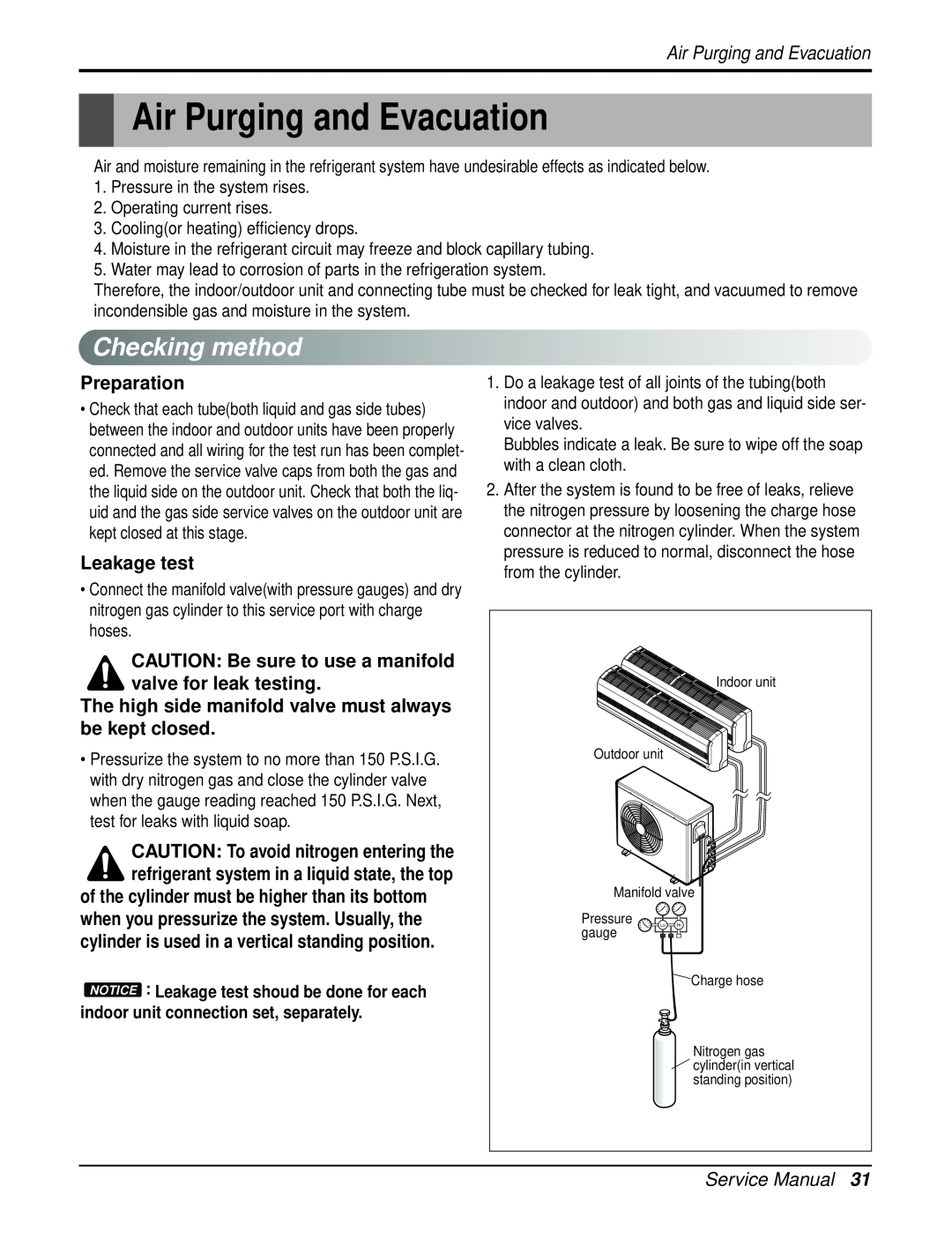Air Conditioning/Heat Pump
Only for authorized service personnel
HEAT CONTROLLER, INC
Wall Mounted Multi-SplitSystem
TABLE OF CONTENTS
2Multi type Air Conditioner
Combination table
SymbolsUsedinthisManual
Service Manual
Combination table
4Multi type Air Conditioner
Safety Precautions
Installation
Safety Precautions
Do not install, remove, or re
Safety Precautions
Service Manual
an Authorized Service Center
6Multi type Air Conditioner
Safety Precautions
When the product is soaked
installing the product
Installation
Safety Precautions
Install the drain hose to ensure that
8Multi type Air Conditioner
Operational
Safety Precautions
•They may burn or explode
Safety Precautions
Service Manual
•Be careful and avoid personal injury
Split Type Indoor
Dimensions
Dimensions
IndoorUnit
UE 18kBtu/h
OutdoorUnit
Dimensions
Service Manual
Outdoor Unit
Product Specifications
Product Specifications
12Multi type Air Conditioner
B-DMH18DB-1
Product Specifications
Service Manual
Indoor Unit
Installation
Installation
InstallationParts
InstallationTools
Indoor unit
Select the best location
Installation
Rooftop Installations
Multi Piping Type
Piping length and elevation
16Multi type Air Conditioner
Installation
Installation
Fixing Installation Plate
Service Manual
18Multi type Air Conditioner
Flaring Work and Connection of Piping
Flaringwork
Flaring Work and Connection of Piping
Flaring Work and Connection of Piping
Connecting the Piping
For right rear piping
Service Manual
Flaring Work and Connection of Piping
20Multi type Air Conditioner
Service Manual
For left rear piping
Flaring Work and Connection of Piping
Indoor unit installation
22Multi type Air Conditioner
Flaring Work and Connection of Piping
HOW TO MOUNT ONTO A WALL HOW TO INSERT BATTERIES
REMOTE CONTROL PREPARATIONOPTIONAL
Flaring Work and Connection of Piping
Flaring Work and Connection of Piping
24Multi type Air Conditioner
Outdoor
Line voltage 208~230V
Connectthe cabletotheIndoorunit
Service Manual
Flaring Work and Connection of Piping
26Multi type Air Conditioner
Connectthe cabletotheOutdoor unit
Every wire must be connected firmly
How to connect wiring to the terminals
Connectionmethod ofthe connectingcableExample
Service Manual
28Multi type Air Conditioner
Connectthecable totheindoorunit
rating on the unit rating plate
Drain piping
Checkingthedrainage
Service Manual
To check the drainage
30Multi type Air Conditioner
Formingthe piping
Air Purging and Evacuation
Service Manual
Air Purging and Evacuation
Checkingmethod
Finishing the job
Evacuation
32Multi type Air Conditioner
Repeat evacuation procedure for each indoor unit
Charging
Charging
Important:Unit is critically charge
Prepare remote control
Test Running
Test Running
34Multi type Air Conditioner
Operation
Operation
Functionofcontrol
1. MAIN UNIT FUNCTION
Fuzzy Operation
36Multi type Air Conditioner
Operation
Defrost ControlHeating
Operation
On-TimerOperation
Off-TimerOperation
Service Manual
Operation
38Multi type Air Conditioner
Off-Timer = On-TimerOperation
Sleep Timer Operation
Buzzer Sounding Operation
Service Manual
Operation
Forced Operation
Time Delay Safety Control
FunctionofIndoorUnit
40Multi type Air Conditioner
Operation ON/OFF by Remote controller
Operating Step
FunctionofOutdoor Unit
Service Manual
Operation
7ON/OFF TIMER BUTTONS
RemoteControlOperation
42Multi type Air Conditioner
SETTING BUTTONS
To remove the Grille from the Chassis
Disassembly
Disassembly
Indoor Unit
3.To remove the Discharge Grille
44Multi type Air Conditioner
Disassembly
2. To remove the Control Box
6.To remove the Cross-FlowFan
Service Manual
Disassembly
5.To remove the Motor Cover
1.Indoor Unit
Schematic Diagram
Schematic Diagram
ElectronicControlDevice
Schematic Diagram
2. Outdoor Unit
TMP87CM41F
Schematic Diagram
48 Multi type Air Conditioner
Service Manual
Wiring Diagram
1. Room Type Indoor Unit 2. Outdoor Unit
Schematic Diagram
• BOTTOM VIEW
ComponentsLocations
1. Indoor Unit
•TOP VIEW
2. Display ASSEMBLY 1 Split Type 6871A20682A
Schematic Diagram
1 Component side
3. Outdoor Unit
52Multi type Air Conditioner
Schematic Diagram
2 Solder side
Schematic Diagram
54Multi type Air Conditioner
Troubleshooting Guide
RefrigerationCycleDiagram
Troubleshooting Guide
Troubleshooting Guide
Indoor Error
Outdoor Error
Self-diagnosisFunction
Troubleshooting Guide
CycleTroubleshooting Guide
Trouble analysis
56Multi type Air Conditioner
Troubleshooting Guide
ElectronicPartsTroubleshooting Guide
Trouble
The Product doesn’t operate at all
Trouble
Product doesnt operate with the remote controller
58Multi type Air Conditioner
Troubleshooting Guide
Trouble
The Compressor/Outdoor Fan are dont operate
Troubleshooting Guide
Service Manual
Troubleshooting Guide
Trouble 4 When indoor Fan does not operate
When indoor Fan does not operate
60Multi type Air Conditioner
Service Manual
Trouble 5 When the louver does not operate
When Vertical Louver does not operate
Troubleshooting Guide
Trouble Shooting
ErrorCode
62Multi type Air Conditioner
Troubleshooting Guide
Title
Troubleshooting Guide
Power input AC 230V.Outdoor, Indoor
• The connecting wires are misconnected
Cause of error
64Multi type Air Conditioner
Troubleshooting Guide
Error
Title
Service Manual
Troubleshooting Guide
Cause of error
2-wayValve Liguid Side
2-way, 3-wayValve
2-way, 3-wayValve
66Multi type Air Conditioner
2.Operate the unit for 10 to 15 minutes
1 Pumping down
Service Manual
2-way, 3-wayValve
2-way, 3-wayValve
2 Evacuation
68Multi type Air Conditioner
7.Mount the valve caps and the service port caps
After Evacuation
3 Gas Charging
Service Manual
2-way, 3-wayValve
05/15/07
HEAT CONTROLLER, INC
1900 WELLWORTH AVENUE • JACKSON, MICHIGAN
THE QUALITY LEADER IN CONDITIONING AIR
